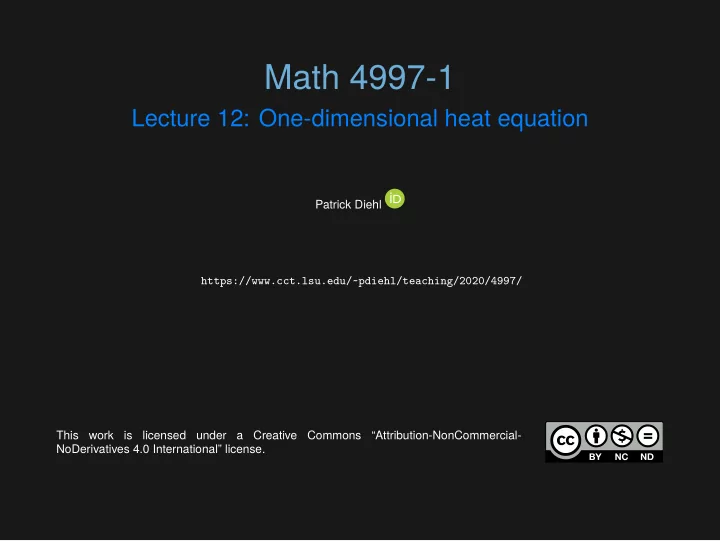

Math 4997-1 Lecture 12: One-dimensional heat equation Patrick Diehl https://www.cct.lsu.edu/~pdiehl/teaching/2020/4997/ This work is licensed under a Creative Commons “Attribution-NonCommercial- NoDerivatives 4.0 International” license.
Reminder Heat equation Serial implementation Summary References
Reminder
Lecture 12 What you should know from last lecture ◮ What is HPX ◮ Asynchronous programming using HPX ◮ Shared memory parallelism using HPX
Heat equation
Heat equation Statement of the heat equation homogeneous and isotropic medium. The heat equation computes the fmow of heat in a Compact form where alpha is the difgusivity of the material. More details [1]. � � ∂ x 2 + ∂ 2 u ∂ 2 u ∂ y 2 + ∂ 2 u ∂ u ∂ t = α ∂ z 2 ˙ u = α ∇ u
Easiest case 1D heat equation Boundary conditions The solution of the heat equation requires boundary conditions ∂ t = α ∂ 2 u ∂ u 0 ≤ x ≤ L , t > 0 ∂ x 2 , ◮ u (0 , t ) = u 0 ◮ u ( L , t ) = u L ◮ u ( x , 0) = f 0 ( x )
Discretization L h Discrete mesh where N is the total number of nodes and h is given by x 1 x 2 x 3 x 4 x 5 x 6 0 x i = ( i − 1) h , i = 1 , 2 , . . . , N h = L / N − 1 .
Finite difgerence method Approximation of the fjrst derivative Approximation of the second derivative Note that a second-order central difgerence scheme is applied. More details [3, 2]. ∂ u ∂ x ≈ u i +1 − u i 2 h ∂ x 2 ≈ u i − 1 − 2 u i + u i +1 ∂ u h 2
Discretization in space and time x t t i L t i +1 t i − 1 x 1 x 2 x 3 x 4 x 5 x 6 0
Serial implementation
Time measurement and system information Time measurement std::uint64_t t = hpx::util::high_resolution_clock::now(); // Do work std::uint64_t elapsed = hpx::util::high_resolution_clock::now() - t; Accessing system information std::uint64_t const os_thread_count = hpx::get_os_thread_count(); std::cout << "Computation took " << elapsed << " on " << os_thread_count << " threads" << std::endl;
Discretization scheme L (alpha*dt/(h*h)) * (left - 2*middle + right); return middle + { double right) double middle, static double heat(double left, Approximation of the heat equation } t 1 t 0 x 1 x 2 x 3 x 4 x 5 x 6 0
Swapping the data t=1 return U[nt % 2]; // Return the solution at time-step 'nt'. s.resize(nx); for (space& s : U) std::vector<space> U(2); // U[t][i] is the state of position i at time t. { space do_work(std::size_t nx, std::size_t nt) Swapping function t=2 t=0 U[0] U[1] U[0] } x 1 x 2 x 3 x 4 x 5 x 6 x 7 x 8 x 9
Do the actual work // Actual time step loop for (std::size_t t = 0; t != nt; ++t) { space const& current = U[t % 2]; space& next = U[(t + 1) % 2]; next[0] = heat(current[nx-1], current[0], current[1]); for (std::size_t i = 1; i != nx-1; ++i) next[i] = heat(current[i-1], current[i], current[i+1]); next[nx-1] = heat(current[nx-2], current[nx-1], current[0]); }
Initial conditions u ( x , 0) = f ( i , 0) , with f (0 , i ) = i for i = 1 , 2 , . . . , N u 2.0 1.5 80 1.0 0.5 60 0.0 40 0.5 1.0 20 1.5 2.0 0 2 1 0 1 2
Solution Parameters u 2.0 80 1.5 70 1.0 60 0.5 50 0.0 0.5 40 1.0 30 1.5 20 2.0 2 1 0 1 2 ◮ heat transfer coeffjcient k = 0.5 ◮ time step size dt = 1.; ◮ grid spacing h = 1.; ◮ time steps nt = 45;
Summary
Summary After this lecture, you should know ◮ One-dimensional heat equation ◮ Serial implementation
References
References I [1] John Rozier Cannon. The one-dimensional heat equation . Number 23. Cambridge University Press, 1984. [2] Randall J LeVeque. Finite difgerence methods for ordinary and partial difgerential equations: steady-state and time-dependent problems , volume 98. Siam, 2007. [3] John C Strikwerda. Finite difgerence schemes and partial difgerential equations , volume 88. Siam, 2004.
Recommend
More recommend